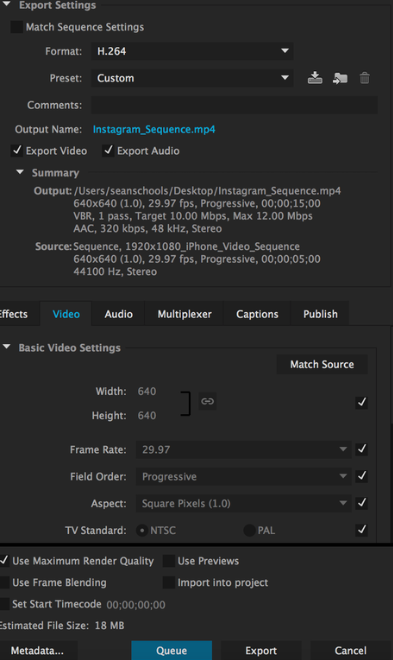Now that you know how to make and submit a video, let’s take a look at the dimensions Instagram recommends for uploading a video.
Instagram Video Requirements
In 2013, when Instagram launched videos at first, each might only be 15 seconds long and appear in-feed. Now, videos are a bit more complex. Each kind has been refined to recommended specs that work the best relying on where you post your content.
Instagram Video Specs/Dimensions for 2019
The current video requirements are as follows: Landscape video, 600 x 315; Square video, 600 x 600; Vertical video, 600 x 750; Carousel advert, 600 x 600; Instagram stories, 600 x 1067; Instagram TV, 1080 x 1920.
The best part of the deal is how simple making Instagram videos could be. Shoot right from an iPhone or Android and automatically fit within the specs for video. iPhone X and Android 9 phones shoot in 4K and have Instagram’s dimensions, 30 and 60 fps built-in.
Size-wise, since Instagram is a phone-forward app, a smartphone has the aspect ratio of 9:16 Instagram recommends. Then, we are going to get into the specifics of these size numbers, in case you are not utilizing a phone for your content.
Instagram Video Size
Your Instagram video could be broadcast in a myriad of sizes and aspect ratios, however, the three main in-feed video sizes are 600 x 315 for landscape, 600 x 600 for square, and 600 x 750 for vertical.
Other Instagram video requirements stay in the same ballpark, we have listed a quick cheat sheet for you below.
Instagram video resolution
- Landscape video – Minimum resolution is 600 x 315
- Square video – Minimum resolution is 600 x 600
- Vertical video – Resolution is 600 x 750
- Carousel advert resolution – Minimum is 600 x 600, while the max resolution is 1080 x 1080
- Instagram Tales – Minimum resolution is 600 x 1067, and the recommended resolution is 1080 x 1920
- Instagram TV video – Resolution is recommended to be 1080 x 1920, while the minimum resolution is 720
Aspect ratios are a different method of looking at the dimensions for videos. If you have somebody who speaks in aspect ratios, aspect ratios for the 3 main kinds of in-feed video are as follows:
- Landscape video – Aspect ratio 16:9
- Square video – Aspect ratio is 1:1
- Vertical video – Aspect ratio 4:5
- Instagram Live – Aspect ratio 9:16
You may utilize a landscape video when you are publishing a video in-feed for a product launch countdown or podcast preview. Landscape videos are also the format for Instagram Live and Stories, such as this Starbucks Story Highlight that incorporates a meme and features their premiere drinks.
When you are looking for a longer video option that displays full-screen videos such as Stories, Instagram TV (IGTV) may be a great alternative. IGTV permits you to have extremely long-form content, like a detailed product video or a live-streamed platform question and answer session.
Cooler firm Yeti uses its IGTV channel to share customer stories, recipes, and even showcase their SXSW sessions. Notice how the videos are longer due to IG’s 60 minute length and landscape.
Square videos are the specialty of NPR Music’s Tiny Desk series. To give highlights of their live performance sessions, NPR utilizes its Instagram and puts their content in square format.
Content previews and highlights from other channels are a good way to use square video formats. When you have got wider videos that you wish to include in-feed or a client/employee spotlight, square videos are the way to go for their compact aspect ratio.
How to Compress Videos for Instagram
Compressing videos means you lower the size of the file to make it simpler to post and faster to stream. Generally, you will add your media to a compression tool or software — like YouCompress or Clipchamp that automatically remove certain data details of your video. Compression may result in the loss of some resolution quality or sound clarity.
Kinds of compression
A video coder is then used to compress bigger video files into different formats. Two common formats are mp4 files and WMV, Windows Media Video files. There are two different types of compression: lossless and lossy.
Lossy Compression
Lossy compression compresses video by removing data from the video files. Removing repeated photos or sounds the software sees as redundant improves the video’s effectiveness. Lossy compression is aptly named, however, it will make your file extremely small.
Compression formats, like lossy, are good at removing a big bit of redundant data to reduce your file size. For example, in case your video has a 5 second shot of the same object, lossy compression may remove three seconds of it.
Lossless Compression
Lossless compression, however, produces a near-identical compression of the original file, because data just isn’t lost in the process. Lossless will not have as large of an impact on file size as lossy, however, it’s still helpful for smaller videos.
Common lossless formats are:
- Windows Media Audio Lossless (WMAL)
- Apple Lossless Audio Codec (ALAC)
- Free Lossless Audio Codec (FLAC).
When your file should concentrate on high quality, use FLAC, since you will not lose any quality in the compression process.
There are a number of video compression tools that will compress videos for you. For instance, UniConverter has an Instagram compression option that’s simple and free to use.
Best Adobe Premiere Pro Export Settings for Instagram
When you are editing your video utilizing Adobe Premiere Pro, you already know Adobe likes to get into the specifics of exporting. We do too. If you get ready to export, here’s the info on the best settings to select for crystal-clear photos.
Open “Export Settings” in the “Format” drop-down box and choose “H.264’ and “Match Source High bitrate” in the preset box. These two settings will match Instagram’s video settings.
The “Use Maximum Render Quality” checkbox fixes the scaling of your video automatically, so make sure to check that box as well.

Image Source: Premiere Bro
Once these settings are saved, your post will be Instagram-ready. Because you cannot add videos directly to Instagram, consider a third-party app like Later or Hootsuite. You could also send the video to your phone and publish it from there.

